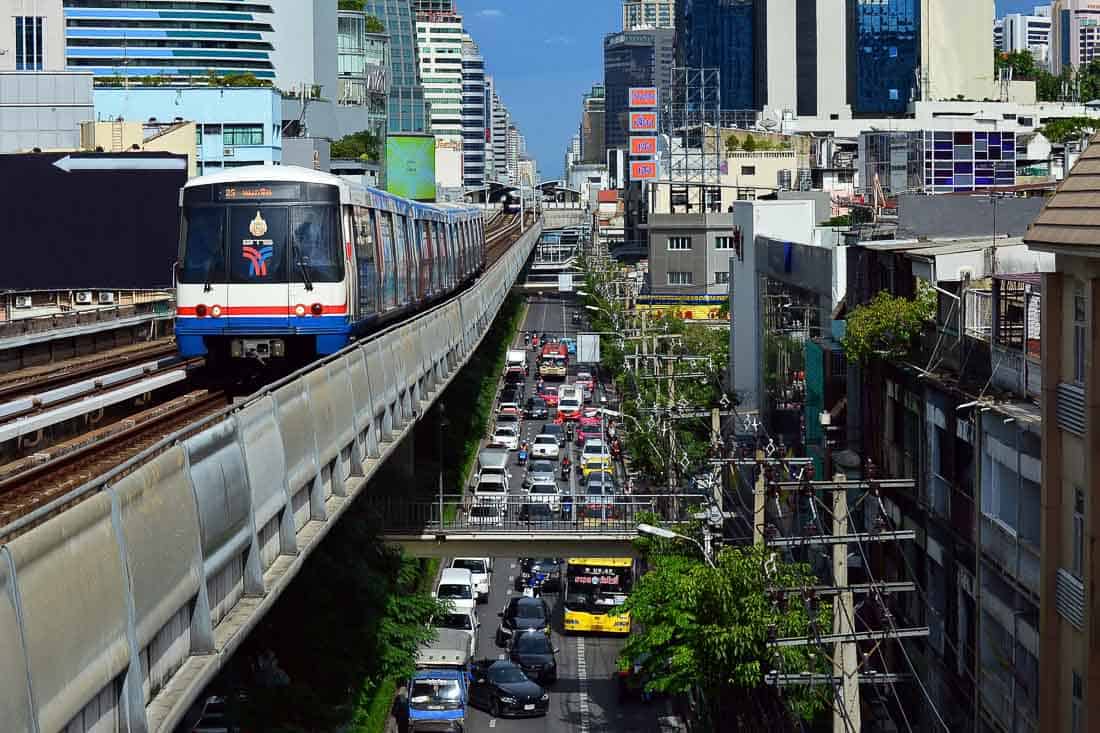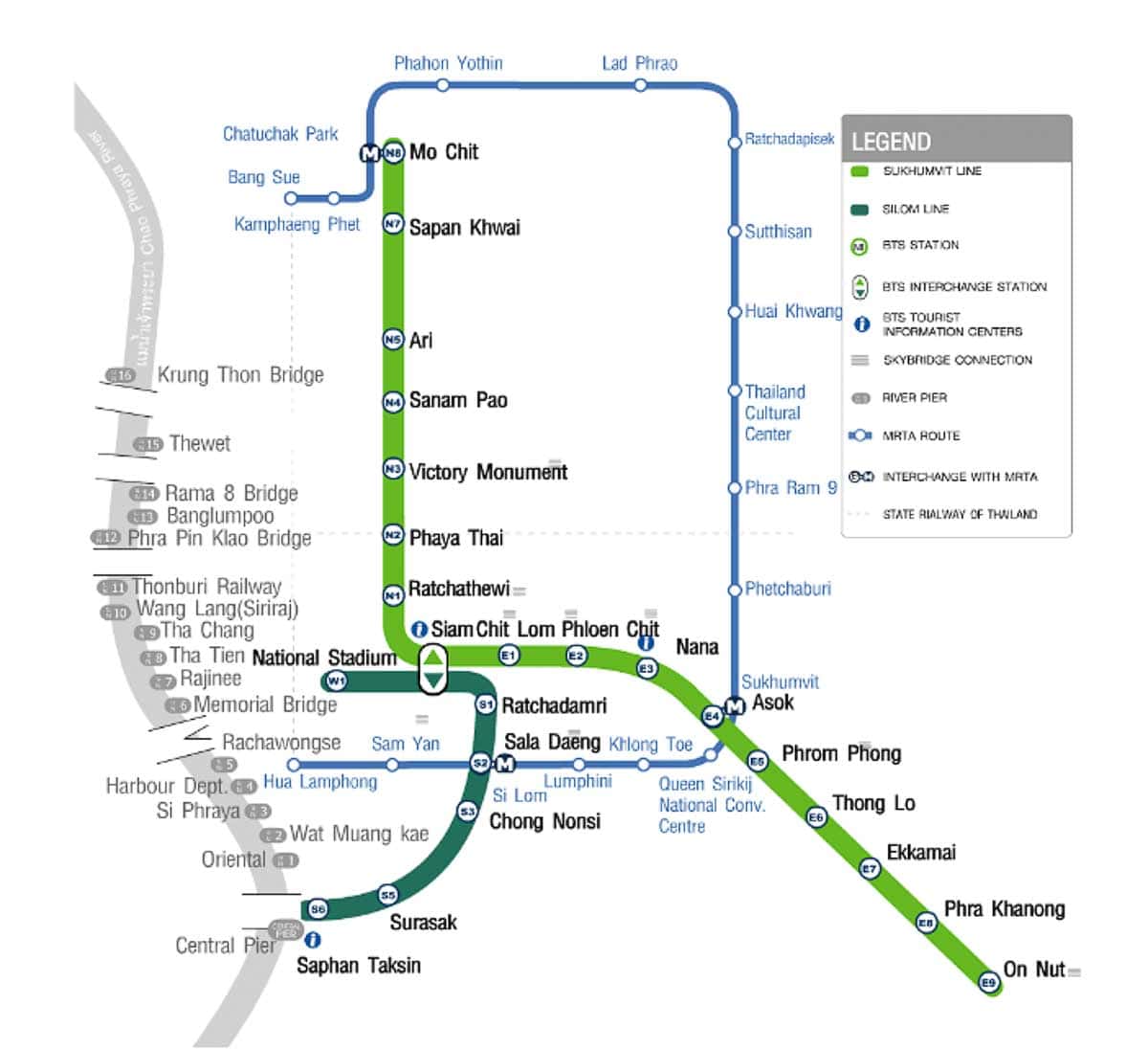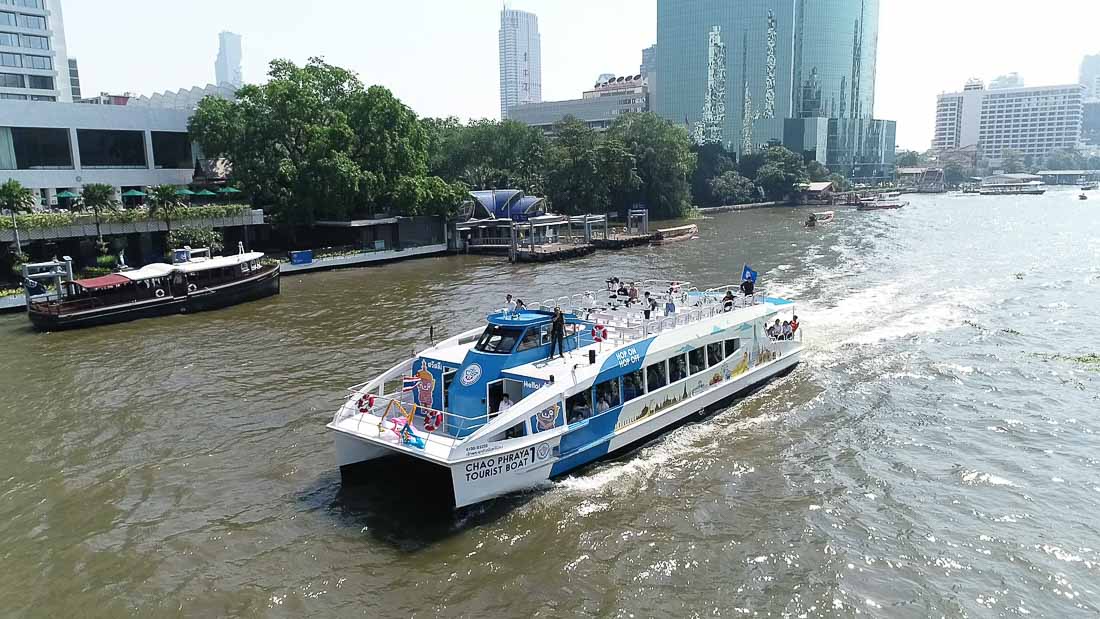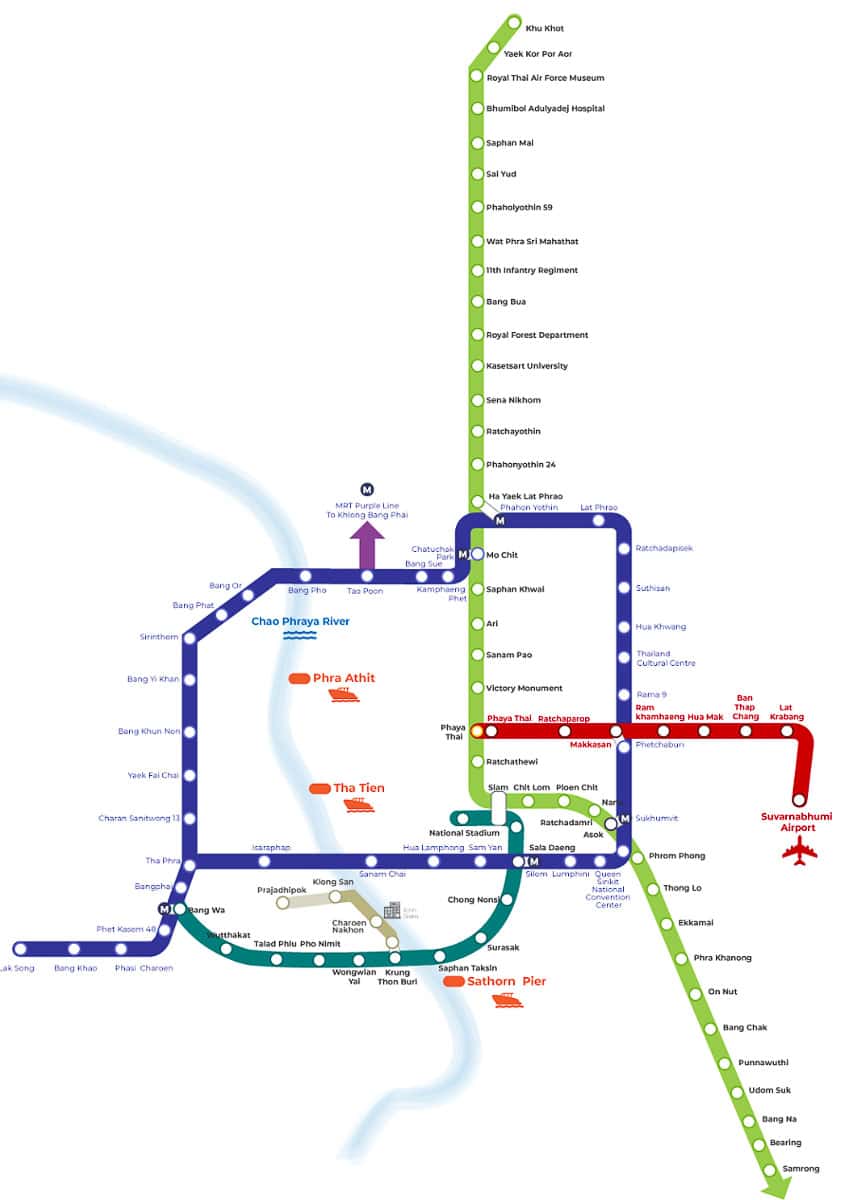Planning a trip to Bangkok and now wondering exactly how to get around Bangkok? Then read on; you’re in the right place, as this guide will cover exactly how to travel around Bangkok.
Bangkok – one of the biggest and busiest cities in the world! Despite all this, it really is a fabulous place to take the kids, at least for a few days, before you head to one of the more tranquil destinations in Thailand.
Being such a big city, it can be a bit daunting trying to figure out how to get around Bangkok. However, rest assured that with a little knowledge, it’s really not too difficult at all.
To help you plan how to get around in Bangkok to visit all the popular tourist attractions, we’ve put together this getting around in Bangkok guide. The guide details all the ways for travelling around Bangkok, including tips on how to get to and from the Bangkok airport.
Talk to other families about their tips on visiting Bangkok and join our Thrifty Family Travel Facebook Group or get inspired by our Instagram.
This post may contain compensated links. Please refer to my disclaimer here for more information.
How to get around Bangkok?
Let’s jump straight into it and help you decide the best way to get around Bangkok with the kids.
Taxi
When travelling with multiple kids, particularly little kids, often the easiest and sometimes even cheapest way to travel in Bangkok (by the time you consider numerous public transport fares) is just taking a taxi.
The taxi service Bangkok offers have to use their meters, so make sure it’s running before you set off.
The meter starts at 35 THB ($1.50 AUD), and journeys to most places in central Bangkok will cost between 50 THB ($2.20 AUD) to 100 THB ($4.40 AUD), plus any tolls will be additional. So it’s super cheap!
Note that drivers will not always speak English, so it’s a good idea to have the address in Thai when getting a taxi in Bangkok.
While at times getting a taxi is super convenient – it’s not always. Traffic in Bangkok can be horrific, so if time is of the essence, it may be worth considering public transportation in Bangkok – see more about this below. In fact sometimes even walking will be quicker!
Sometimes, we found the taxi drivers refused to use their meters and bartered with us. So it’s up to you to either accept this price or find another taxi driver who will use their meter. Sometimes, during peak hour, you’re better off just bartering and accepting a price you’re happy with.
Grab
Like most places in the world, you can also use ride share for going around Bangkok. Grab is the ride share company most common in Bangkok, so make sure you have this downloaded on your phone.
Grab is often easier to use than a taxi because everything is organised via the App – including ordering the ride, putting in where you want to go and you’ll see the price of the journey upfront, so there will be no surprises.
You can also use the App to pay, or you can pay cash to the driver.
However, I don’t recommend using Grab in a super busy area! The reason is that often you don’t get to set the pick up location – the App will set a location close by and you will need to meet the driver there. At times, we found the pick up location impossible and often gave up trying!
So in a super busy area, you’re better off finding a taxi on the street and jumping in.
Tuk-tuks
Tuk tuks are the iconic motorised rickshaws that you have no doubt seen before and most people coming to Bangkok will want to ride in a tuk tuk at least once!
However, note that in terms of how to move around in Bangkok, this is probably the most expensive and inconvenient way.
You’ll need to most likely haggle with your driver and pay a price much more than a taxi or Grab, and the ride will most likely be hot and sweaty and you’ll be among all that noisy traffic and pollution.
However, it is fun and the kids will love it – so do try it at least once!
Tuk Tuks are super easy to find – they’re everywhere and any way they will find you – just listen out for someone calling “tuk tuk”.
How to use public transport in Bangkok?
Bangkok public transport includes trains, buses and boats.
In terms of trains, there are two forms of transportation: the Skytrain (also called the BTS) and the Metro (also called the MRT) – both are discussed in detail below.
While there is public bus transportation in Bangkok – to get around the city easily – I think it’s best to focus on trains and possibly boats – so we won’t cover the public buses in Bangkok in this guide.
A full interactive map showing all public transport in Bangkok (excluding boats) can be found here.
Skytrain (BTS)
The Skytrain (also called the BTS) is an elevated train with two lines. The Sukhumvit Line (light green) begins at Kheha Samutprakan Station and ends at Khu Khot Station and the Silom Line (dark green) begins at Bang Wa Station and ends at National Stadium Station.
In several places, the BTS system connects with Bangkok’s Metro system, which also includes the Airport Rail Link and the newly launched yellow line.
Below is a map of the Skytrain within the central area of Bangkok; see further down for a full map.
Finding a Skystation is easy – they are above ground, so you can easily see them.
The Skytrain runs every 5 to 8 minutes between 6 am and midnight.
How to buy tickets for the Skytrain (BTS)
There are a few ways to buy Skytrain tickets, but the most common way is using a ticket machine, which you will find inside the station.
You will need cash to pay, as credit/debit cards are not accepted. Also, note that not all machines take notes, but all take coins. If you don’t have enough coins, you can find a ticket office at the station, change your notes, or buy your ticket there.
Using the machines is fairly easy, and you can choose to have the language in English (in the image above, I hadn’t changed it to English yet). Then you just choose your destination and how many tickets you’d like, and then the total fare will appear. Now add your money to the machine and then take your tickets.
Ticket prices range from 16 THB ($0.70 AUD) to 62 THB ($2.65 AUD) or 150 THB ($6.40) for a day pass. Children under 90cm are free, but children above this height pay the full fare.
You should check a few fares here before deciding if it’s worth it to purchase a Bangkok BTS one day pass or just pay for single tickets as you go. You’d probably want to use the Skytrain 3 to 4 times in a day before a day pass is worth it – this, of course, depends on where you’re going.
When buying single tickets, you may need to line up to buy them each time, which may make a day pass more convenient as you only have to line up to buy it once. Although we never found a line up when we purchased tickets – but we were travelling outside of peak hour.
If you want to be prepared, you can purchase day passes here online and pick them up from the Klook booth once you arrive at Suvarnabhumi Airport – it’s on level 4 of the Departure Hall and is open 24 hours.
Once you have your ticket, you walk to the gates and use your ticket to touch on. The gates will then open and you can walk through. If you have children under 90cm, you must carry them as you go through the gates.
When you exit the station, you will insert your ticket into a slot. The ticket isn’t returned to you as it’s only valid for a single journey. If you’ve purchased a day pass, you will just touch on with the ticket and keep the ticket.
Rabbit Card
In terms of Skytrain fares, there is another option that you may consider and that is a Rabbit Card.
You probably have heard of these types of cards – where you have a card that you top up with money which is deducted from the card as you touch on and off when getting on the train.
As well as using on the Skytrain, you can also use your Rabbit Card on the Chaopraya Tourist boat – more about that below.
Rabbit Cards cost 100 THB ($4.25 AUD) and then you add money to the card for fares.
You can buy a Rabbit Card at any BTS Station or purchase it online here and pick it up from the Klook booth once you arrive at Suvarnabhumi Airport – it’s on level 4 of the Departure Hall and open 24 hours.
Whether a Rabbit Card is worth it for you depends on how long you’re in Bangkok and how much you intend to use the Skytrain.
Taking the Skytrain (BTS)
To find the correct platform for your journey, you will need to know the last station of the line you are taking – this is how the platforms are named. So, even if you’re only going a station or two ahead, you will need to find the platform with the station’s name at the end of the line you are taking.
To locate the correct platform, it is recommended you check a map at the station first.
It’s also important to check the map, as chances are, your journey will require you to swap lines or even swap from the Skytrain to the Metro.
Once on the train, keep an eye on maps and electronic displays, which will keep you updated with your location.
If, once on the train, you realise you’re heading in the wrong direction, simply get off the train at the next stop and change platforms – no need to purchase a new ticket, provided you don’t exit the station.
If this sounds a little overwhelming – please don’t be concerned – it really is very easy – just do one step at a time and you’ll be fine.
Metro (MRT)
The metro system (also called the MRT) is a cheap way to get around Bangkok. Below is a map of the MRT.
Unfortunately, the MRT is independent of the Skytrain, so you will need separate tickets to ride each train. However, the MRT does intersect at various points with the Skytrain, so often taking a combination of each is best to reach your destination.
It’s also worth noting that while there is the yellow MRT line – as it is run by a monorail – this line is considered separate from the broader MRT network and so a separate ticket is also required to ride this sector.
MRT trains run frequently from 6 am to midnight.
How to buy tickets for the Metro (MRT)
There are a few ways to buy MRT tickets, but the most common way is using a ticket machine, which you will find inside the station. You will need cash to pay, as credit/debit cards are not accepted.
Using the machines is easy – you just choose your destination, and the total fare will appear. Now add your money to the machine and then take your ticket, which is actually a token. Unfortunately, you need to purchase tickets one by one.
Ticket prices range from 14 THB ($0.60 AUD) to 43 THB ($1.85 AUD) and fares for children under 14 are 50% of the adult fare.
When buying single tickets, you may need to line up to buy them each time, which may make a day pass more convenient as you only have to line up to buy it once.
Once you have your ticket/token, you walk to the gates and use your token to touch on. The gates will then open and you can walk through. If you have children under 90cm, you must carry them as you go through the gates.
When you exit the station, you will insert your token into a slot. The token isn’t returned to you as it’s only valid for a single journey.
If you’ve purchased a day pass, you will just touch on with the ticket and keep the ticket.
Alternatively, you can just use your credit card to pay for your fare – to do this, you just scan your card as you enter the gates.
MRT Cards and passes
In terms of Metro fares, you can also purchase stored value cards or period passes.
Period passes are either a day pass (120 THB/$5.10 AUD) or a 3 day pass (230 THB/ $9.80 AUD), which allows unlimited travel during the period of the pass. The fare for children under 14 is 50% of the adult fare.
Stored value cards are the type of cards that you top up with money which is deducted from the card as you touch on and off when getting on the train. These cards cost 180 THB ($7.65 AUD) and include 100 THB in travel credits, 50 THB deposit and a 30 THB fee. You can then add additional money to the card as required for fares.
Periodic passes and Stored Value cards can only be purchased at the station ticket offices.
As to whether these cards and passes are worth it, it will depend on how much you intend to use the MRT during your visit to Bangkok.
Taking the Metro (MRT)
To find the correct platform for your journey, you will need to know the last station of the line you are taking – this is how the platforms are named. So, even if you’re only going a station or two ahead, you will need to find the platform with the station’s name at the end of the line you are taking.
To locate the correct platform, it is recommended you check a map at the station first.
It’s also important to check the map, as chances are, your journey will require you to swap lines or even swap from the Metro to the Skytrain.
Once on the train, keep an eye on maps and electronic displays, which will keep you updated with your location.
If, once on the train, you realise you’re heading in the wrong direction, simply get off the train at the next stop and change platforms – no need to purchase a new ticket, provided you don’t exit the station.
Boats
With the Chao Phraya River running through Bangkok and the west bank having an extensive canal system, boats are a popular way of exploring the city.
Tourist attractions like the Grand Palace and Wat Pho Temple are along the river, so boat is a popular way to visit these sites – although not always the quickest way.
There are two main fleets of boats on the river: the Klorng Boats and the Chao Phraya Express Boat.
Chao Phraya River Boats
The main pier for the Chao Phraya River boats is Sathon (also called Central Pier). This pier connects with the Saphan Taksin BTS station, so it can easily be reached from most places within the city.
The Chao Phraya Bangkok Express Boats are distinguished by their different coloured flags.
The orange flag boat stops at most major piers between Rajsingkorn in the south and Nonthaburi in the north. The boat departs daily every 15 – 30 minutes between 6 am and 6 pm and tickets cost a flat 16 THB ($0.70 AUD).
There are also yellow, yellow/green and red flag boats, which are express boats and operate less frequently. These boats cost more as well.
Popular for tourists is the Chao Phraya Blue Express Boat, also known as the tourist boat. These boats run from Central Pier to Phra Athit/Banglamphu Pier, with stops at major sightseeing piers.
The boat departs every 30 minutes from 8:30 am to 7.15 pm, and tickets cost 60 THB ($2.55 AUD), or you can get an all day pass for 200 THB ($8.50 AUD) – although it was only 150 THB on the day we went.
You can purchase your all day tourist boat passes in advance here.
Children under 90 cm are free of charge – so this makes for a great, inexpensive way to get around.
We bought the all-day pass, but in hindsight, we might have been better off just buying tickets as we went. If you have the all day pass, you’re locked into catching the tourist boat – which only comes every 30 minutes.
Plus, due to timing issues, we got a Grab between some attractions rather than really making the most out of the all-day pass. So do consider this when deciding what is the best option for you.
Klong Boats
These are canal taxi boats that run along the Bangkok canals and are an easy way to get between Banglamphu and Jim Thompson House, the Siam Square shopping centres (get off at Sapan Hua Chang Pier for both) and other points further east along Thanon Sukhumvit – after a mandatory change of boat at Pratunam Pier.
These boats are mostly used by daily commuters and can get very busy during peak hours.
Fares range from 10B to 20B and boats run daily from 5.30 am to 8.30 pm.
Cross river ferries
If you just wish to cross the river, countless ferries go back and forth at various points across the river every few minutes all day and into the night, charging just 5 THB ($0.20 AUD).
These are super easy to catch – you’ll see them crossing the river, so just walk up to the dock, buy your ticket from the ticket window and jump on.
For those visiting Wat Pho and Wat Arun – which are directly across the river from each other – this is a convenient method to get between the two temples.
Getting to Bangkok from the Airport
Bangkok is served by two international airports, Don Mueang and Suvarnabhumi, so it’s essential to know which airport you are arriving in before arranging your transport to the city.
Don Mueang International Airport
Don Mueang International Airport is around 24 km from the city centre, and the easiest way to get to and from here is via taxi.
The cost is between 180 to 220 THB (which includes tolls and airport charges) depending on the traffic (approximately $8 – $10 AUD).
You don’t need to haggle; just follow the signs to the taxi rank, ignoring those who offer you a taxi. Ensure you have some change for the driver because you must pay the tolls as you go, or sometimes the driver will just add the tolls onto the end price.
You can also prearrange private transfers if you prefer someone waiting for you and your family. These aren’t too expensive, and you don’t have to worry as you’ll have someone waiting for you as soon as you land. Transfers are around $70 AUD for a family – click here for more info.
You can take public transport, but it will be long and really not worth the hassle given the price of a taxi or private transfer.
Suvarnabhumi International Airport
There are a few options for Suvarnabhumi (also referred to as Bangkok Airport).
The cheapest option is to take the Airport Rail Link (the red line on the map below) into the city.
You can take the train from the airport to Phaya Thai BTS station, where you can change to the Skytrain (45 THB ($1.91 AUD) and takes 26 minutes) or take it to Makkasan, where you can switch to the MRT (35 THB ($1.50 AUD) and 22 minutes). Kids under 12 are free, and tickets can be purchased at the airport station.
Once you reach Bangkok, take a local train or taxi to your hotel.
The Airport Rail Link operates daily from 6 am to midnight and the train departs every 10 minutes or so.
However, with your family and luggage in tow, the easiest way to get to and from the airport is via taxi. The cost is between 350 to 500 THB (which includes tolls and airport charges) depending on the traffic (approximately $15 – $22 AUD).
You don’t need to haggle; just follow the signs to the taxi rank, ignoring those who offer you a taxi. Ensure you have some change for the driver because you will need to pay the tolls as you go, or sometimes the driver will just add the tolls onto the end price.
You can also prearrange private transfers if you prefer someone waiting for you and your family. These aren’t too expensive, and you don’t have to worry as you’ll have someone waiting for you as soon as you land. Transfers are around $45 for a family – click here for more info.
____________________________________________________________________________
I hope you enjoyed this guide on all the getting around Bangkok helpful. Other guides that you might helpful include things to do in Bangkok with kids or the best family hotels in Bangkok.











